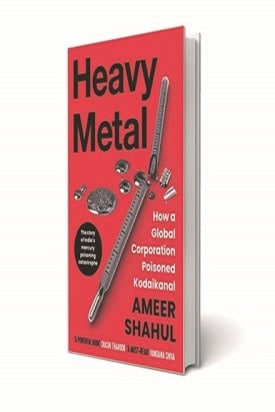By Soma Das
Former Unilever CEO Paul Polman, who once aspired to be a priest and is known as the face of sustainable capitalism globally, was more used to fielding questions from worried shareholders on whether his overzealous focus on sustainability is compromising the financial performance of his company. The book Heavy Metal by a former journalist and former Greenpeace activist Ameer Shahul adds a knotty twist to that tale by taking readers into a side-lane of the history of Hindustan Unilever Ltd (HUL), an Indian subsidiary of Unilever. HUL has been considered a poster boy of corporate responsibility, mainly by betting on a ‘healthy planet and society’ and intertwining its brand with that philosophy.
Shahul, in an expose style, meticulously tells the story of how a thermometer factory acquired by HUL poisoned the pristine south Indian hill station of Kodaikanal by dumping excess mercury in a scrapyard for years that may have caused invisible and unmeasurable damage to humanity, forest flora and fauna and grasslands biome dominated by shola trees. The book follows the battle between local communities backed by global NGO Greenpeace and HUL on pinning accountability for the irresponsible manufacturing practices that failed to keep a trail of the dangerous mercury meant for thermometers.

The detail-rich narration follows the case from the boardrooms to courtrooms, from company AGMs to newsrooms, and from factory premises to the hospital records of workers who might have died prematurely or rendered handicapped in many ways due to mercury exposure. The book drums up clear echoes of the unforgettable Bhopal gas tragedy caused by Union Carbide.
What the book also reveals is the anatomy of a green campaign and what it takes in terms of innovation and guts to design and sustain one in the midst of chaos and setbacks—to barge into formal corporate meetings, to seek attention of the media, to conduct painstaking research to convert experience into evidence, to not give up in the face of failure, and be ready to follow up the fight for decades.
In building plentiful context, many side stories become tributaries to the central story of Kodaikanal’s mercury pollution. Replete with business history, the book tells us how a petroleum residue on the rods of oil pumps that workers in petroleum fields used to heal bruises with became Vaseline petroleum jelly; how Hindustan Lever Ltd’s (HLL, as HUL was formerly known) head of India circumvented the prospect of price control over soaps by launching a cheap soap called Saral; the detergent war between HLL’s Surf and Nirma that led to the birth of detergent brand Wheel from the stable of HLL; how brand Lakme was born out of Jawahar Lal Nehru’s concerns about India spending too much forex on imported beauty products; how HUL India’s then boss Vindi Banga lost out the top job at Unilever to Paul Polman partly due to the mercury-spilling fiasco in India; how HUL’s projection as a water-sensitive organisation owes its origin to McKinsey’s long-term business strategy for the company; how it was the price war on water purifiers that led to Hindustan Unilever Foundation, and many other interesting stories.
On top of the central story and the side stories, the book raises many critical questions—isn’t India turning a blind eye to the occupational hazards that its workers suffer, do we have robust systems to compensate people who may not even know that their jobs are costing them their lives, how do we address the web of conflict of interests that our expert committees are made up of, do we have enough disclosure mechanisms to ensure that people who earn from a company cannot become a jury pronouncing a verdict on them, and finally, when a company like HUL that is so conscious of its brand image has shown this level of gross negligence, what do we make of many others in business who have less of a reputation to protect. In short, this speaks as much about the company as it does about the regulatory environment that has allowed it to do so.
Shahul has managed to keep the story interesting and alive.
This part-memoir and part-analysis is a piece of investigative journalism spanning decades that will become reference material for students of environmental disasters in India. Much to HUL’s embarrassment, this well-researched book will ensure that what was till now a speculative alternate history known in patches will now be embedded into their mainstream history.
Shahul’s excellent efforts in red-jacketed Heavy Metal deserves definite green salutes. The author, however, is not an independent observer but an insider, a character in the story which he witnessed as a Greenpeace activist. This is both the strength of the book and its weakness. The strength comes from knowing the intricate details and telling the story with a passion that’s not possible for an outsider to do. The weakness is that at times our passion and position can cloud our judgment to impute motives without evidence and merit. For instance, if a former head of HLL found a calling in Mother Teresa’s cause, how fair is it for the author to dub these relationships as ‘astute’ and ‘strategically significant’?
Similarly, for several experts in many committees who may have exonerated the company from wrongdoing or failed to prove the damage the mercury caused, it could be the ‘lack of evidence’, or their incompetence or a plain case of a different opinion. As a journalist, Shahul would know that HUL may have a story to tell as well, and that’s the missing link here. These are small cribs of ‘coloured lenses’ in an otherwise brilliant book, that will make sure that the mercury ghost will haunt HUL for times to come. It’s not a ‘daag’ that HUL can ever claim as ‘achhe hain’.
Heavy Metal
Ameer Shahul
Pan Macmillan
Pp 416, Rs 799
Soma Das is the author of The Reluctant Billionaire and an adviser to multiple agencies in the development space








